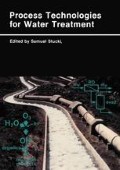Abstract
The use of direct current electricity to increase the rate of dialysis of electrolytes or to produce demineralized water from potable water has been known for about 100 years. Early cells used three compartments between a single pair of electrodes, the compartments being separated from each other by (porous) diaphragms. The latter were essentially neutral and not intrinsically electrically conducting. Electrode reactions were important to this variety of electrodialysis which might better be regarded as a double electrometathesis, anions in the central electrodialysis compartment being replaced by hydroxide from the cathode compartment, cations by hydrogen ions from the anode compartment. It was noted that the choice of diaphragms affected the ultimate pH in the central compartment. Such three compartment ED cells were sold before World War II for water demineralization.
Access this chapter
Tax calculation will be finalised at checkout
Purchases are for personal use only
Preview
Unable to display preview. Download preview PDF.
References
Meyer, K.H. and Strauss, W., Helv. Chim. Acta 23 (1940) 795–800.
J. Wilson, ed., Demineralization by Electrodialysis (Butterworths Scientific Publ., London) 1960.
Clarke, J.T., U.S. Pats. 2,730,768; 2,780,604; 2,800,445.
Glueckauf, E., Proc. Royal Soc. A 268 (1962) 339 .
Glueckauf, E., Proc. Royal Soc. A 268 (1962) 350.
Frilette, J., J. Phys. Chem. 60 (1956) 435.
Glueckauf, E. and Kitt, G.P., J. Appl. Chem. 6 (1956) 511.
Leite, F.B., U.S. Pats. 3,562,139 and 3,654,125.
Dege, G.J. et al., U.S. Pat. 4,024,043.
Chang, Y. (Ph.D. Thesis, Columbia University, New York) 1979.
Simons, R., Nature 280, 30 (1979) 824.
Simons, R., Desalination 28 (1979) 41.
Grossman, G. et al, Desalination 10 (1972) 157.
Simons, R., Electrochim. Acta 30, 1 (1985).
Simons, R., Electrochim. Acta 30, (1985) 275.
Further Readings
Helfferich, F., Ion Exchange (McGraw-Hill, New York) 1962.
Kate, W., Electrodialysis preparation of boiler feed and other demineralized waters. Proc. Am. Power Conf. 33 (1971) 830–40; Electrodialysis for low TDS waters. Ind. Water Eng. June/July (1971).
Lakshminarayanaiah, N., Chem. Rev. 65 (1965) 491.
Mason, E. et al., Design of electrodialysis equipment. Chem. Eng. Prog. Symp. Ser. 55 (1959) 173–89.
McRae, W. “Electrodialysis” in Kirk-Othmer Encyclopedia of Chemical Technology, 3rd ed., Vol. 8 (Wiley, New York) 1978–1984, pp. 725 et seq.; “Electrodialysis” Chap. 8 in Desalination Technology, A. Porteous, ed. (Applied Science, London) 1983.
Shaffer, L. et al., “Electrodialysis” Chap. IV in Principles of Desalination, K.S. Spiegler, ed. (Academic Press, New York) 1966.
Solt, G., “Electrodialysis” Chap. 6 in Membrane Separation Processes, P. Meares, ed. (Elsevier, Amsterdam) 1976; “Electrodialysis” Chap. 12 in Industrial Electrochemical Processes, A. Kuhn, ed. (Elsevier, Amsterdam) 1971.
Spiegler, K. “Electrodialysis” in Perry’s Chemical Engineers’ Handbook, R. Perry et al., eds., 6th ed. (McGraw-Hill, New York) 1984, pp. 17–37.
Author information
Authors and Affiliations
Rights and permissions
Copyright information
© 1988 Plenum Press, New York
About this chapter
Cite this chapter
McRae, W. (1988). Electrodialysis. In: Process Technologies for Water Treatment. Earlier Brown Boveri Symposia. Springer, Boston, MA. https://doi.org/10.1007/978-1-4684-8556-1_5
Download citation
DOI: https://doi.org/10.1007/978-1-4684-8556-1_5
Publisher Name: Springer, Boston, MA
Print ISBN: 978-1-4684-8558-5
Online ISBN: 978-1-4684-8556-1
eBook Packages: Springer Book Archive

